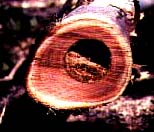The Termites
 Termites are primitive insects which form the order of Isoptera, and
although often mistakenly referred to as "white ants" which are in
fact no relation. They are in fact relatives of the cockroach. Whilst
some build underground, other construct large mounds in the open or
eat timber. In each mound, there is a queen who can produce 30 000
eggs a day. Besides tree termites nowadays also eat away from the
inside, buildings, fences. In the Northern of Australia, the termites
best known to live in and eating out the centre of living trees is
the Coptotermes acinaciformes who then fills the hollow with waste
matter.
Termites are primitive insects which form the order of Isoptera, and
although often mistakenly referred to as "white ants" which are in
fact no relation. They are in fact relatives of the cockroach. Whilst
some build underground, other construct large mounds in the open or
eat timber. In each mound, there is a queen who can produce 30 000
eggs a day. Besides tree termites nowadays also eat away from the
inside, buildings, fences. In the Northern of Australia, the termites
best known to live in and eating out the centre of living trees is
the Coptotermes acinaciformes who then fills the hollow with waste
matter.
Timbers
 Wooden didjeridoos are varieties form 'piped' eucalyptus branches
('suppressed stems'). 'Termites nest in these malformed branches,
eating the wood from the inside outwards. The species most often selected
for didjeridu tubes in coastal regions of Arnhem Land (fig I, area
'N') include stringy bark (Eucalyptus tetrodonta) and woolybutt (E.
miniata). The River Red gum ( E.camaldulensis) is chosen by north
Australian didjeridu players at places nearer to Katherine and further
south. A didjeridoo at Maningrida was made form a palm, probably Livistona
humilis (Moyle1974:7, note z).
Wooden didjeridoos are varieties form 'piped' eucalyptus branches
('suppressed stems'). 'Termites nest in these malformed branches,
eating the wood from the inside outwards. The species most often selected
for didjeridu tubes in coastal regions of Arnhem Land (fig I, area
'N') include stringy bark (Eucalyptus tetrodonta) and woolybutt (E.
miniata). The River Red gum ( E.camaldulensis) is chosen by north
Australian didjeridu players at places nearer to Katherine and further
south. A didjeridoo at Maningrida was made form a palm, probably Livistona
humilis (Moyle1974:7, note z).
Excluding 'instant' didjeridus, such as lengths of iron piping or the tailshafts of land-rovers, wooden instruments seem to more durable than bamboo type has not been measured; but after finding a hollowed branch, the player may chop it down, remove the bark covering, smooth the surfaces, whittle the mouth end, mould beeswax or gum round the rim and have the instrument ready for testing (with the singer) within a space of few hours.
